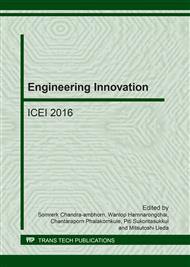[1]
J. G. Fisher, D. Rout, K. S. Moon, S. L. Kang, Structural changes in potassium sodium niobate ceramics sintered in different atmospheres, J. Alloy. Comp. 479 (2009) 467–472.
DOI: 10.1016/j.jallcom.2008.12.100
Google Scholar
[2]
S. J. Liu, B. Wan, P. Wang, S. H. Song, Influence of A-site non-stoichiometry on structure and electrical properties of (Na0. 5K0. 5)NbO3-based lead-free piezoelectric ceramics, Script Mater. 63 (2010) 124–127.
DOI: 10.1016/j.scriptamat.2010.03.033
Google Scholar
[3]
W. Yang, D. Jin, T. Wang, J. Cheng, Effect of oxide dopants on the structure and electrical properties of (Na0. 5K0. 5)NbO3-LiSbO3 lead-free piezoelectric ceramics, Physica B. 405 (2010) 1918–(1921).
DOI: 10.1016/j.physb.2010.01.074
Google Scholar
[4]
S. Zhang, R. Xia, T. R. Shrout, G. Zang, Characterization of lead free (K0. 5Na0. 5)NbO3–LiSbO3 piezoceramic, Solid State Commun. 141 (2007) 675–679.
DOI: 10.1016/j.ssc.2007.01.007
Google Scholar
[5]
Y. Zhou, M. Guo, C. Zhang, M. Zhang, Hydrothermal synthesis and piezoelectric property of Ta-doping K0. 5Na0. 5NbO3 lead-free piezoelectric ceramic, Ceram. Int. 35 (2009) 3253–3258.
DOI: 10.1016/j.ceramint.2009.05.018
Google Scholar
[6]
X. Yan, W. Ren, X. Wu, P. Shi, X. Yao, Lead-free (K, Na)NbO3 ferroelectric thin films: preparation, structure and electrical properties, J. Alloy. Comp. 508 (2010) 129–132.
DOI: 10.1016/j.jallcom.2010.08.025
Google Scholar
[7]
W. Chen, S. Kume, K. Watari, Molten salt synthesis of 0. 94(Na1/2Bi1/2)TiO3–0. 06BaTiO3 powder, Mater. Lett. 59 (2005) 3238-3240.
DOI: 10.1016/j.matlet.2005.04.056
Google Scholar
[8]
G. Z. Zang, J. F. Wang, H. C. Chen, W. B. Su, C. M. Wang, P. Qi, B. Q. Ming, J. Du, L. M. Zheng, Perovskite (Na0. 5K0. 5)1-x(LiSb)xNb1-xO3 lead-free piezoceramics, Appl. Phys. Lett. 88 (2006) 212908.
DOI: 10.1063/1.2206554
Google Scholar
[9]
J. G. Fisher, D. Rout, K. S. Moon, S. J. L. Kang, High-temperature x-ray diffraction and raman spectroscopy study of (Na0. 5K0. 5)NbO3 ceramics sintered in oxidizing and reducing atmospheres, Mater. Chem. Phys. 120 (2010) 263–271.
DOI: 10.1016/j.matchemphys.2009.11.001
Google Scholar
[10]
J. T. Zeng, K. W. Kwok, H. L. W. Chan, KxNa1-xNbO3 powder synthesized by molten-salt process, Mater. Lett. 61 (2007) 409–411.
DOI: 10.1016/j.matlet.2006.04.083
Google Scholar
[11]
Z. Yang, Y. Chang, B. Liu, L. Wei, Effects of composition on phase structure, microstructure and electrical properties of (K0. 5Na0. 5)NbO3–LiSbO3 ceramics, Mater Sci. Eng. A. 432 (2006) 292–298.
DOI: 10.1016/j.msea.2006.06.034
Google Scholar


